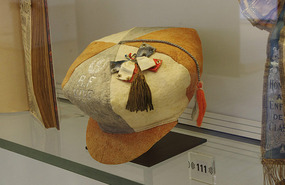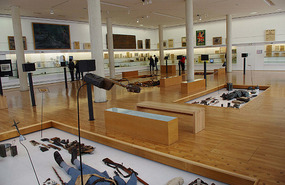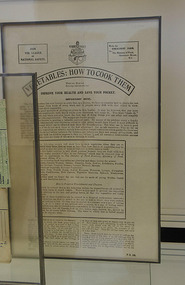Our campsite was located in Peronne, just 1.5 km from the Historial museum. We were camped here to visit the museum and explore the Somme region and various WWI sites. The museum was practically empty with only a few groups of students to contend with. The museum was organized into four rooms, each dealing with specific period of the war from 1914-18. The first room gave an introduction to pre-war Europe and the political tensions and struggles that were taking place.
It spoke of the Austria-Hungarian Empire, Germany's encouragement of Austria to declare war on the Serbs and the assassination of Archduke Franz Ferdinand, which was the primary catalyst for declaring war. There was an interesting map on display that attempted to quantify the main powers at war in terms of their standing army, naval prowess, available war funds (not sure how they obtained this information) and other factors. The map was questionable in its accuracy though because it showed Russia as being wealthier than England. In the display cabinet, one item of particular interest looked like a graduation cap. It was in fact a cap worn by those that were deemed fit to serve in the army – it was worn proudly back then, almost like a rite of passage.
The next room had a series of etchings by Otto Dix, who was a German soldier traumatized during the war. Many of the sketches were very graphic, depicting the harsh reality of war, and definitely not suitable for propaganda material. One sketch of a wounded comrade particularly stood out for me and the soldier’s figure was so contorted, it made his agony look almost unreal. Dix continued to do etchings well into the late 1930s, always depicting the folly of war. This did not sit well with Nazism at the time and he was declared a degenerate artist by the regime. It was interesting to see these sketches from a German soldier as you don’t often get to see things from the perspective of the aggressor.
The following room was about the beginning of the war, with displays of newspaper headlines from that time, recruitment posters and other such items. One of the items I particularly thought was clever was a poster titled "Hark! Hark! The Dogs do Bark!", which characterized each of the European nations as various breeds of dogs and then continued on to relate how the war began by saying, “It was started by a Dachshund that is rumoured to have gone mad – though there was so much method in his madness that this is doubtful”.
Look at the photos below for the rest of the very clever explanation. There was a fair bit mentioned about recruitment tactics used by various governments, especially the recruitment of people from the colonies of the fighting nations. England recruited heavily from the Commonwealth nations including India, Canada, Australia, New Zealand and South Africa. I was surprised to learn that nearly 400,000 Indians fought in the war, even more than Canada’s 350,000. France on the other hand recruited from its territories in Africa whereas Germany solely relied on its own troops. It was also interesting to note was that although the UK didn’t have conscription till 1916, three million voluntarily signed up (the same amount as post 1916). The primary displays in the room were the outfits of a typical soldier from the three main armies: French, British and German. The French outfit was so out-dated for its time that it clearly showed how ill-prepared and foolish the commanding officers were. The likes of Joffre still believed that this war would be fought by the cavalry and close, hand-to-hand combat, thus outfitting French soldiers with trumpets to announce the charge and large swords for fighting. To add to this, they even wore metal breastplates, like in the medieval days to shield against bullets.
The following room displayed some of the weapons of the war – grenades, machine guns, mines, etc.
Interestingly enough, it also highlighted the commercialization of the war and the proliferation of war-related objects. Everyday objects made use of patriotic symbols to promote products, thus making the war an advertising agent. There was also an interesting display on photography and videography equipment from the time. It explained that video cameras at the time were so heavy and required a tripod at all times that nearly all footage of the war that exists today was shot behind the front line and/or pre-staged. The end of the museum visit concluded with the victory of the war, which essentially was due the fact that German troops’ morale and supplies were almost depleted just as the Americans joined the Allied forces. There was a final display outlining the total casualties which seemed to aptly summarize the folly of the entire war: 70 million troops mobilized, almost 10 million killed, not including civilian casualties.
WWI Museum in Peronne
Thursday, March 28, 2013
 Peronne, Picardy, France
Peronne, Picardy, France
Other Entries
-
99Holy Toledo!
Feb 1442 days prior Toledo, Spain and Canary Islandsphoto_camera63videocam 0comment 1
Toledo, Spain and Canary Islandsphoto_camera63videocam 0comment 1 -
100Modernisme sights in Barcelona
Feb 1838 days prior Barcelona, Spain and Canary Islandsphoto_camera225videocam 1comment 1
Barcelona, Spain and Canary Islandsphoto_camera225videocam 1comment 1 -
101Day trip to Sitges
Feb 1937 days prior Sitges, Spain and Canary Islandsphoto_camera11videocam 0comment 0
Sitges, Spain and Canary Islandsphoto_camera11videocam 0comment 0 -
102Cassoulet in Carcassonne
Feb 2630 days prior Carcassonne, Francephoto_camera19videocam 0comment 2
Carcassonne, Francephoto_camera19videocam 0comment 2 -
103Albi: Toulouse-Lautrec & amazing cathedral
Feb 2729 days prior Albi, Francephoto_camera15videocam 0comment 0
Albi, Francephoto_camera15videocam 0comment 0 -
104Bastides in the Lot
Feb 2828 days prior Cordes-sur-Ciel, Francephoto_camera24videocam 0comment 3
Cordes-sur-Ciel, Francephoto_camera24videocam 0comment 3 -
105Return to Rocamadour
Mar 0127 days prior Rocamadour, Francephoto_camera9videocam 0comment 0
Rocamadour, Francephoto_camera9videocam 0comment 0 -
106Market Day in Sarlat
Mar 0226 days prior Sarlat-la-Canéda, Francephoto_camera21videocam 0comment 1
Sarlat-la-Canéda, Francephoto_camera21videocam 0comment 1 -
107Marquessac Gardens
Mar 0325 days prior Vezac, Francephoto_camera29videocam 0comment 2
Vezac, Francephoto_camera29videocam 0comment 2 -
108Three "Plus Beaux Villages"
Mar 0424 days prior Domme, Francephoto_camera18videocam 0comment 0
Domme, Francephoto_camera18videocam 0comment 0 -
109A day for chores
Mar 0523 days prior Sarlat-la-Canéda, Francephoto_camera13videocam 0comment 1
Sarlat-la-Canéda, Francephoto_camera13videocam 0comment 1 -
110Relaxing in the Dordogne
Mar 0919 days prior Beynac-et-Cazenac, Francephoto_camera54videocam 0comment 2
Beynac-et-Cazenac, Francephoto_camera54videocam 0comment 2 -
111Prehistoric Art in the Dordogne
Mar 1117 days prior Les Eyzies-de-Tayac, Francephoto_camera15videocam 0comment 1
Les Eyzies-de-Tayac, Francephoto_camera15videocam 0comment 1 -
112Market Day in Brantome
Mar 1513 days prior Brantome, Francephoto_camera23videocam 0comment 1
Brantome, Francephoto_camera23videocam 0comment 1 -
113Chateau de Fontainebleau
Mar 1711 days prior Fontainebleau, Francephoto_camera53videocam 0comment 0
Fontainebleau, Francephoto_camera53videocam 0comment 0 -
114Chateau de Vaux-le-Vicomte
Mar 199 days prior Vaux-le-Vicomte, Francephoto_camera51videocam 0comment 0
Vaux-le-Vicomte, Francephoto_camera51videocam 0comment 0 -
115Paris
Mar 271 day prior Paris, Francephoto_camera139videocam 2comment 2
Paris, Francephoto_camera139videocam 2comment 2 -
116WWI Museum in Peronne
Mar 28 Peronne, Francephoto_camera41videocam 0comment 1
Peronne, Francephoto_camera41videocam 0comment 1 -
117"Van"dalism
Mar 291 day later Peronne, Francephoto_camera3videocam 0comment 0
Peronne, Francephoto_camera3videocam 0comment 0 -
118Memorials of the Somme
Mar 313 days later Albert, Francephoto_camera29videocam 0comment 0
Albert, Francephoto_camera29videocam 0comment 0 -
119Vimy Ridge
Apr 014 days later Vimy, Francephoto_camera26videocam 0comment 0
Vimy, Francephoto_camera26videocam 0comment 0 -
120Ypres and WWI Memorials
Apr 036 days later Ypres, Belgiumphoto_camera57videocam 0comment 0
Ypres, Belgiumphoto_camera57videocam 0comment 0 -
121Belgian Treats in Bruges
Apr 058 days later Brugge, Belgiumphoto_camera55videocam 0comment 0
Brugge, Belgiumphoto_camera55videocam 0comment 0 -
122More Belgian Treats in Ghent
Apr 069 days later Ghent, Belgiumphoto_camera28videocam 0comment 1
Ghent, Belgiumphoto_camera28videocam 0comment 1 -
123Moules in Dunkerque
Apr 0710 days later Dunkerque, Francephoto_camera11videocam 0comment 1
Dunkerque, Francephoto_camera11videocam 0comment 1 -
124Côte d’Opal
Apr 0912 days later Wimereux, Francephoto_camera14videocam 0comment 1
Wimereux, Francephoto_camera14videocam 0comment 1 -
125Van repaired and a visit to Brighton
Apr 1114 days later Brighton, United Kingdomphoto_camera16videocam 0comment 1
Brighton, United Kingdomphoto_camera16videocam 0comment 1 -
126Open Air Museum in Arnhem
Apr 1417 days later Arnhem, Netherlandsphoto_camera55videocam 0comment 2
Arnhem, Netherlandsphoto_camera55videocam 0comment 2 -
127Amsterdam
Apr 1720 days later Amsterdam, Netherlandsphoto_camera72videocam 0comment 2
Amsterdam, Netherlandsphoto_camera72videocam 0comment 2 -
128Aalsmeer Flower Auction
Apr 1821 days later Aalsmeer, Netherlandsphoto_camera47videocam 3comment 0
Aalsmeer, Netherlandsphoto_camera47videocam 3comment 0 -
129Cheese Market in Alkmaar
Apr 1922 days later Alkmaar, Netherlandsphoto_camera62videocam 0comment 0
Alkmaar, Netherlandsphoto_camera62videocam 0comment 0 -
130The Historic Triangle
Apr 2023 days later Hoorn, Netherlandsphoto_camera81videocam 2comment 3
Hoorn, Netherlandsphoto_camera81videocam 2comment 3 -
131Fishing Village of Marken
Apr 2124 days later Marken, Netherlandsphoto_camera21videocam 0comment 1
Marken, Netherlandsphoto_camera21videocam 0comment 1 -
132Edam, Tulips & Windmills
Apr 2225 days later Lisse, Netherlandsphoto_camera49videocam 0comment 1
Lisse, Netherlandsphoto_camera49videocam 0comment 1 -
133Canal Boating on the Bourgogne
May 0134 days later Migennes, Francephoto_camera110videocam 5comment 3
Migennes, Francephoto_camera110videocam 5comment 3 -
134Trapped by the Floods
May 0437 days later Fleurey-sur-Ouche, Francephoto_camera48videocam 1comment 0
Fleurey-sur-Ouche, Francephoto_camera48videocam 1comment 0

 Peronne, Picardy, France
Peronne, Picardy, France













































2025-05-22